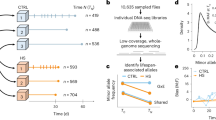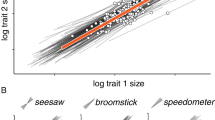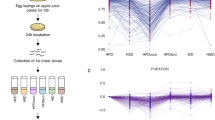Abstract
The abundance of transposable elements and DNA repeat sequences in mammalian genomes raises the question of whether such insertions represent passive evolutionary baggage or may influence the expression of complex traits. We addressed this question in Drosophila melanogaster, in which the effects of single transposable elements on complex traits can be assessed in genetically identical individuals reared in controlled environments1. Here we demonstrate that single P-element insertions in the intergenic region between the gustatory receptor 5a (Gr5a, also known as Tre)2,3,4 and trapped in endoderm 1 (Tre1)5, which encodes an orphan receptor, exert complex pleiotropic effects on fitness traits, including selective nutrient intake, life span, and resistance to starvation and heat stress. Mutations in this region interact epistatically with downstream components of the insulin signaling pathway. Transposon-induced sex-specific and sex-antagonistic effects further accentuate the complex influences that intergenic transposable elements can contribute to quantitative trait phenotypes.
This is a preview of subscription content, access via your institution
Access options
Subscribe to this journal
Receive 12 print issues and online access
$209.00 per year
only $17.42 per issue
Buy this article
- Purchase on Springer Link
- Instant access to full article PDF
Prices may be subject to local taxes which are calculated during checkout



Similar content being viewed by others
References
Mackay, T.F.C. The genetic architecture of quantitative traits. Annu. Rev. Genet. 35, 303–339 (2001).
Dahanukar, A., Foster, K., van der Goes van Naters, W.M. & Carlson, J.R. A Gr receptor is required for response to the sugar trehalose in taste neurons of Drosophila. Nat. Neurosci. 4, 1182–1186 (2001).
Ueno, K. et al. Trehalose sensitivity in Drosophila correlates with mutations in and expression of the gustatory receptor gene Gr5a. Curr. Biol. 11, 1451–1455 (2001).
Chyb, S., Dahanukar, A., Wickens, A. & Carlson, J.R. Drosophila Gr5a encodes a taste receptor tuned to trehalose. Proc. Natl Acad. Sci. USA 100, 14526–14530 (2003).
Kunwar, P.S., Starz-Gaiano, M., Bainton, R.J., Heberlein, U. & Lehmann, R. Tre1, a G protein-coupled receptor, directs transepithelial migration of Drosophila germ cells. PLoS Biol. 1, 372–384 (2003).
King, M.C. & Wilson, A.C. Evolution at two levels in humans and chimpanzees. Science 188, 107–116 (1975).
Carroll, S.B. Evolution at two levels: on genes & form. PLoS Biol. 3, e245 (2005).
Andolfatto, P. Adaptive evolution of non-coding DNA in Drosophila. Nature 437, 1149–1152 (2005).
The Chimpanzee Sequencing and Analysis Consortium. Initial sequence of the chimpanzee genome and comparison with the human genome. Nature 1, 69–87 (2005).
Bellen, H.J. et al. The BDGP gene disruption project: single transposon insertions associated with 40% of Drosophila genes. Genetics 167, 761–781 (2004).
Alcedo, J. & Kenyon, C. Regulation of C. elegans longevity by specific gustatory and olfactory neurons. Neuron 41, 45–55 (2004).
Harbison, S.T., Yamamoto, A.H., Fanara, J.J., Norga, K.K. & Mackay, T.F.C. Quantitative trait loci affecting starvation resistance in Drosophila melanogaster. Genetics 166, 1807–1823 (2004).
Larsen, P.L., Albert, P.S. & Riddle, D.L. Genes that regulate both development and longevity in Caenorhabditis elegans. Genetics 139, 1567–1583 (1995).
Kimura, K.D., Tissenbaum, H.A., Liu, Y. & Ruvkun, G. daf-2, an insulin receptor-like gene that regulates longevity and diapause in Caenorhabditis elegans. Science 277, 942–946 (1997).
Ogg, S. et al. The Fork head transcription factor DAF-16 transduces insulin-like metabolic and longevity signals in C. elegans. Nature 389, 994–999 (1997).
Kenyon, C., Chang, J., Gensch, E., Rudner, A. & Tabtiang, R.A. C. elegans mutant that lives twice as long as wild type. Nature 366, 461–464 (1993).
Clancy, D.J. et al. Extension of life-span by loss of CHICO, a Drosophila insulin receptor substrate protein. Science 292, 104–106 (2001).
Tatar, M. et al. A mutant Drosophila insulin receptor homolog that extends life-span and impairs neuroendocrine function. Science 292, 107–110 (2001).
Liang, H. et al. Genetic mouse models of extended lifespan. Exp. Gerontol. 38, 1353–1364 (2003).
Holzenberger, M., Kappeler, L. & De Magalhaes Filho, C. IGF-1 signaling and aging. Exp. Gerontol. 39, 1761–1764 (2004).
Hwangbo, D.S., Gersham, B., Tu, M.P., Palmer, M. & Tatar, M. Drosophila dFOXO controls lifespan and regulates insulin signaling in brain and fat body. Nature 429, 562–566 (2004).
Lukacsovich, T. et al. Dual-tagging gene trap of novel genes in Drosophila melanogaster. Genetics 157, 727–742 (2001).
Tanimura, T., Isono, K., Takamura, T. & Shimada, I. Genetic dimorphism in the taste sensitivity to trehalose in Drosophila melanogaster. J. Comp. Physiol. [A] 147, 433–437 (1982).
Anholt, R.R.H. et al. The genetic architecture of odor-guided behavior in Drosophila: epistasis and the transcriptome. Nat. Genet. 35, 180–184 (2003).
Storey, J.D. & Tibshirani, R. Statistical significance for genome wide studies. Proc. Natl Acad. Sci. USA 100, 9440–9445 (2003).
Partridge, L., Gems, D. & Withers, D.J. Sex and death: what is the connection? Cell 120, 461–472 (2005).
Du, K., Herzig, S., Kulkarni, R.N. & Montminy, M. TRB3: A tribbles homolog that inhibits Akt/PKB activation by insulin in liver. Science 300, 1574–1577 (2003).
Acknowledgements
This work was supported by grants from the US National Institutes of Health (T.F.C.M., R.R.H.A.) and by the Technical and Scientific Council of Turkey TUBITAK (E.D.O.).
Author information
Authors and Affiliations
Contributions
All authors contributed to the experimental design and statistical analysis of data. S.M.R., R.R.H.A. and T.F.C.M. wrote the manuscript. S.M.R. measured starvation resistance and trehalose preference and performed molecular genetic analyses, M.M.M. measured life span, E.D.O. and T.J.M. measured heat stress, and A.Y. maintained D. melanogaster lines and constructed revertant lines.
Corresponding authors
Ethics declarations
Competing interests
The authors declare no competing financial interests.
Supplementary information
Supplementary Table 1
Loci with altered transcriptional regulation in P-element insertion lines. (PDF 93 kb)
Rights and permissions
About this article
Cite this article
Rollmann, S., Magwire, M., Morgan, T. et al. Pleiotropic fitness effects of the Tre1-Gr5a region in Drosophila melanogaster. Nat Genet 38, 824–829 (2006). https://doi.org/10.1038/ng1823
Received:
Accepted:
Published:
Issue Date:
DOI: https://doi.org/10.1038/ng1823



